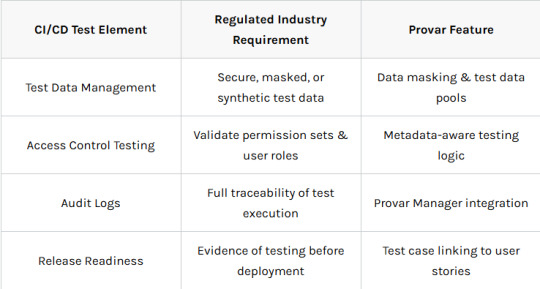#end-to-end testing
Explore tagged Tumblr posts
Text

in all timelines in all possibilities only you can show me this
#artists on tumblr#Arcane#jayvik#Jayce Talis#Viktor#arcane spoilers#my art#I saw That Shot (you know the one) and my brain broke with how beautiful it was#and then I was like wait those colors... oh my god what if...#aaaand I've always wanted to draw the klimt kiss ref#looks like these two were the ones who got it in the end hah#but phew this tested me in so many ways with figuring things out
65K notes
·
View notes
Text
From Code Commit to Production: Best Practices for CI/CD Testing in Regulated Industries

Let’s be real—working in a regulated industry like finance, healthcare, or government isn’t for the faint of heart. When you’re building on Salesforce and releasing updates fast, you need testing that’s not just thorough, but smart. And that’s where CI/CD test automation comes in. More specifically, that’s where Provar can be your best friend.
In this blog, we’ll walk you through how test automation can help you move from code commit to production with confidence—and compliance. Whether you’re navigating HIPAA, GDPR, or SOC2, we’ve got best practices that make the whole process smoother.
Why Regulated Industries Need CI/CD Testing More Than Ever Regulated industries face stricter scrutiny. You’re expected to deliver updates at the pace of modern business but with zero tolerance for defects. That’s a tough balance. Manual testing just doesn’t cut it anymore, especially when audits are looming and every release needs traceability.
Here’s what makes testing in these industries uniquely challenging:
Audit requirements: Full traceability of who did what, when, and why.
Data sensitivity: Personal and financial data must be handled securely.
Strict regulations: HIPAA, GDPR, SOX, PCI-DSS—you name it.
Frequent updates: Salesforce changes every few weeks, and so do compliance expectations.
That’s why continuous integration and continuous delivery (CI/CD) combined with test automation isn’t a luxury anymore—it’s a necessity.
How CI/CD Testing Works in a Regulated Environment In the world of CI/CD, code is constantly being integrated, validated, and deployed. When done right, it reduces bugs, accelerates feedback, and ensures quality at every step. But for regulated industries, you need extra guardrails. This is where Provar makes a huge difference.
The typical CI/CD testing journey with Provar looks like this:
Developer commits code to Git (feature branch).
Provar automated tests are triggered instantly through tools like Jenkins or GitHub Actions.
Tests run on a secure sandbox—isolated and compliant with internal data policies.
Test logs, results, and audit trails are stored for review (and for that upcoming audit!).
Once all tests pass, the code is deployed automatically to staging or production.
Provar’s CI/CD integration ensures all of this happens with minimal manual touch, reducing human error and maintaining compliance posture.
Best Practices for CI/CD Test Automation in Regulated Industries
Build Compliance into Every Test: Don’t just test functionality—test for compliance. Provar allows you to incorporate validation rules, permission sets, and field-level security into your automated test cases. That means you’re checking if users only access the data they’re supposed to, every time.
Automate Traceability: Auditors love logs. With Provar, every test execution can be logged, timestamped, and linked to the related user story or requirement. That makes it easy to prove compliance without digging through spreadsheets and emails.
Shift Left with Smart Tests: The earlier you find a bug, the cheaper it is to fix. ProvarDX, our CLI tool, lets you integrate testing into your development process from the first commit. You catch issues before they hit production—and before they cost you money or credibility.
Keep Test Data Secure: Regulations like HIPAA and GDPR care about how data is stored and processed. Provar supports data masking and synthetic data creation, so you can run realistic tests without compromising real user data.
Monitor, Adapt, Repeat: Salesforce releases happen three times a year. Compliance standards evolve just as fast. Build a review cycle into your CI/CD pipeline so you’re always one step ahead of the next big change.
Quick Reference: Compliance Readiness Checklist

Why Provar is Built for This Provar was designed from the ground up with Salesforce in mind—and with compliance as a core focus. Unlike traditional test automation platforms that struggle with dynamic Salesforce metadata, Provar understands your org’s structure, language, and workflows natively.
Whether you’re a healthcare provider securing PHI or a bank adhering to SOX, Provar gives you the tools to test with confidence—and compliance.
Final Thoughts From code commit to production, testing in regulated industries is no easy feat. But with the right tools and approach, it becomes manageable—and even empowering. With Provar’s CI/CD capabilities, test automation becomes more than just a safety net. It becomes your competitive edge.
If your organization is looking to stay compliant while speeding up delivery, it’s time to bring Provar into your CI/CD pipeline. Learn more here.
#Best Practices for CI/CD Testing#automated testing#salesforce testing#provar#provar tool#end-to-end testing#automation testing
0 notes
Text
#Performance Testing#Security Testing#Load Testing#Software Optimization#Application Security#QA Performance#Cybersecurity Testing#Stress Testing#Mobile App Testing#Android Testing#iOS App Testing#Cross-Device Testing#Mobile QA#Mobile Automation Testing#App Performance Testing#Real Device Testing#Functional Testing#Software QA#Feature Validation#System Testing#Manual Testing#Automated Functional Testing#End-to-End Testing#Black Box Testing#ETL Testing#Data Validation#Data Warehouse Testing#BI Testing#Database QA#Data Quality Checks
0 notes
Text
9 Different Types of Software Testing and Their Benefits
In the world of software development, ensuring the quality and reliability of an application is paramount. Software testing plays a vital role in identifying bugs, ensuring functionality, and enhancing the overall user experience. Testing can be done at different stages of development and can take many forms. Each type of testing has its own objectives, processes, and benefits. In this blog, we’ll explore the most common types of software testing and why each is crucial in delivering a high-quality product.

1. Unit Testing
What it is: Unit testing focuses on testing individual units or components of a software application in isolation, typically at the function or method level. Developers often write unit tests as they write the code, making it a proactive approach to catching errors early.
Benefits:
Early Detection of Bugs: Unit tests can catch issues as soon as code is written, making it easier and faster to fix bugs.
Simplifies Code Maintenance: With unit tests, developers can make changes to the code with confidence, knowing that existing functionality is not broken.
Documentation: Unit tests act as documentation for the behavior of individual code components, making it easier for others to understand how a system works.
2. Integration Testing
What it is: Once individual units of code are tested, integration testing ensures that they work together as expected. This type of testing focuses on detecting issues that occur when different components of the software interact.
Benefits:
Identifies Interface Issues: It helps to ensure that the interfaces between different modules or services are functioning correctly.
Early Detection of Integration Problems: Problems like data mismatches, incorrect APIs, or failures in service calls can be identified before they affect the entire system.
Improved Software Design: By testing components together, developers can ensure that the overall system architecture is sound and scalable.
3. System Testing
What it is: System testing evaluates the complete, integrated system as a whole. This testing verifies that the entire application works according to the specified requirements and functions well in all expected environments.
Benefits:
End-to-End Validation: System testing ensures that all parts of the application work together seamlessly, offering a real-world simulation of the software in action.
Comprehensive Coverage: It tests all aspects of the system (performance, security, usability, etc.), ensuring that no part is overlooked.
Ensures Functional and Non-Functional Requirements Are Met: System testing confirms that the software not only works functionally but also meets performance, security, and usability standards.
4. Acceptance Testing
What it is: Acceptance testing is performed to determine whether the software meets the business requirements and if it is ready for deployment. Often performed by QA teams or the client, this test is done before the product is released to the market.
Benefits:
Validates Business Requirements: Ensures that the software delivers what the client or end-users expect and that all features and functionalities align with the business needs.
Reduces the Risk of Rework: By identifying issues early on, acceptance testing helps ensure that the product is ready for use and minimizes the need for costly post-release fixes.
Improves Stakeholder Confidence: Since it focuses on meeting client specifications, it helps in building trust with stakeholders and ensures their satisfaction with the final product.
5. Performance Testing
What it is: Performance testing is conducted to determine how a software application performs under various conditions. It focuses on aspects like speed, responsiveness, scalability, and stability. There are several types of performance testing, including load testing, stress testing, and scalability testing.
Benefits:
Improves User Experience: Ensures that the software can handle high user loads without slowing down or crashing, which directly impacts user satisfaction.
Identifies Bottlenecks: Performance testing helps uncover areas of the software that could cause slowdowns, allowing developers to optimize performance before it becomes an issue.
Scalability Insights: Helps teams understand how well the software can handle increasing volumes of data or users, and allows them to plan for future growth.
6. Security Testing
What it is: Security testing is designed to find vulnerabilities in the software application that could be exploited by hackers or malicious users. This includes testing for issues like SQL injection, cross-site scripting (XSS), data breaches, and authentication flaws.
Benefits:
Protects Sensitive Data: Ensures that sensitive user data (such as personal details, credit card information, etc.) is secure and not susceptible to cyberattacks.
Compliance with Regulations: Many industries have strict regulatory standards (e.g., GDPR, HIPAA) regarding data security, and security testing helps ensure compliance.
Prevents Security Breaches: By proactively identifying vulnerabilities, security testing can prevent data leaks, fraud, or other security breaches that could damage the company’s reputation or finances.
7. Usability Testing
What it is: Usability testing evaluates how user-friendly and intuitive a software application is. This type of testing focuses on ensuring that the product is easy to navigate and that users can interact with it efficiently.
Benefits:
Improved User Experience: Helps identify interface issues that may confuse or frustrate users, allowing teams to make the software more intuitive.
Better Customer Retention: A well-designed, user-friendly product is more likely to satisfy users and encourage them to continue using the software.
Increased Conversion Rates: A seamless user experience can lead to higher engagement, more sign-ups, and ultimately more conversions or sales.
8. Regression Testing
What it is: Regression testing ensures that new code changes (such as bug fixes, enhancements, or feature additions) haven’t unintentionally affected the existing functionality of the software. It’s typically done after each update or release.
Benefits:
Prevents New Bugs: Ensures that new code doesn't break previously working features, which is crucial as the software evolves over time.
Maintains Software Stability: Regression testing helps maintain the stability of the system by verifying that old functionality continues to work as expected.
Speeds Up Release Cycles: Automated regression tests can quickly check for issues, reducing the time needed for quality assurance and speeding up the release cycle.
9. Smoke Testing
What it is: Smoke testing, also known as "build verification testing," is a preliminary test to check the basic functionality of a software build. It’s like a "quick check" to ensure that the critical parts of the software work before deeper testing is performed.
Benefits:
Quick Feedback: Provides immediate feedback on whether the latest build is stable enough to proceed with further testing.
Reduces Time and Cost: Helps to catch fundamental issues early in the development cycle, preventing wasted time on testing broken builds.
Ensures Build Quality: It ensures that the most crucial features (e.g., login, key workflows) are functioning correctly before testing begins.
Conclusion
Software testing is an essential component of the development lifecycle, ensuring that applications are not only functional but also secure, efficient, and user-friendly. Each type of testing serves a unique purpose and brings its own set of benefits, from identifying small bugs in individual components to ensuring the overall performance and security of the application.
By implementing various types of testing at different stages of development, software teams can significantly reduce the risk of errors and deliver a more reliable, high-quality product to end-users. Whether you're a developer, QA engineer, or project manager, understanding the importance of diverse testing strategies is key to successful software delivery.
#Unit Testing#Integration Testing#System Testing#Acceptance Testing#Performance Testing#Security Testing#Usability Testing#Regression Testing#Smoke Testing#Software testing#End-to-End Testing
0 notes
Text
hero/villain showdown but one of them has a spontaneous medical emergency and the battle gets put on hold while their archnemesis drives them to Urgent Care
#it should be like. a hernia. or diverticulitis#something intestinal for maximum Awkward Scenario#and the entire car ride alternates between awkward silence and the driver lecturing their nemesis on the importance of regular check-ups#this is funnier if the hero is the one having the hernia tbh. but both options are Very Good#want to emphasize that it is a 'medical emergency ' that is clearly not extreme enough for the emergency room#and the sidekick/henchperson gets stuck in traffic so the hero/villain stays for moral support#they spend 8 hours in the waiting room playing Uno (it devolves into a screaming match)#at the end of the ordeal one of them vows to burn the hospital to the ground with their laser eye powers#and it's Not The One You Think#oh oh oh! ALTERNATIVELY:#it's an allergic reaction; one of them accidentally poisoned the other by using like. soybean derivative in a tranquilizer dart#emphasis on *accidentally*. yes they were technically fighting but That Wasn't Supposed To Happen#so now they're obligated to take responsibility and Stay In The Waiting Room#(can't decide if it's funnier if it's the hero or the villain stuck in this situation)#(probably the villain)#“why didn't you TELL me you were allergic to soybeans???”#“um because you would use it against me in combat?”#“as opposed to NOT telling me! which has worked out fantastic for you!!!”#villain being genuinely offended bc they have a biochemistry degree and have invented literally dozens of untraceable poisons#they have the scientific skill to poison their favorite jackass in hundreds of ways#(and have done so before! in admittedly non-fatal outcomes but that was by design okay)#but it's “dangerous” to do them the simple curtesy of informing them about a SOY ALLERGY????#above all else they consider themself a scientist#and they're LIVID that their favorite (reluctant) test subject lied about their medical history#“technically i didn't LIE--#“I read you the questionnaire! the very first time i held u hostage i READ YOU THE QUESTIONNAIRE!!!”#“...the what now”#“the MEDI--holy shit you weren't even paying attention were you#i had you bound and gagged over an ACTUAL BUBBLING ACID PIT and you couldn't even be bothered to--#“--so i was obviously a bit BUSY at that moment! I'm sorry i ignored your VILLAINOUS MONOLOGUING while the BLOOD WAS RUSHING TO MY HEAD but
7K notes
·
View notes
Text
Node.js Testing Strategies and Tools
Node.js Testing Strategies and Tools: A Comprehensive Guide
Introduction Testing is a crucial part of the software development process, ensuring that your code works as expected and helps prevent future regressions. In the context of Node.js applications, there are various strategies and tools available to perform testing efficiently. This guide will cover the different types of testing strategies and the tools you can use to implement them in your…
#Chai#code coverage#Cypress#end-to-end testing#integration testing#Mocha#Node.js testing#nyc#Sinon#Supertest#unit testing
0 notes
Text

#p5r#persona 5 protagonist#akechi goro#IM FREEEE IM FREEE IM FREEEEE#IT ONLY TOOK 24 HOURS AND THEN SOME AND 2 MONTHS OF SANITY!!!!!!#im never drawing anything like this again ill be going bsck to 3/4 bust up 0 backgrounds.#persona 5#shuake#ANYWAY. listened to a lot of picture you by chapp3ll roan while drawing this…#and like the correlation isnt there but i think abt all the mutual things….joker bringing rival up twice and akechi being shocked#my art#doodle#doodles#and the way at the end akc thinks that joker wished him back because of pity 😔#do you picture me like i picture you am i in the frame of your point of view…#joker being the only person akc trusts and relies on but is it the same….is it all just pity…..#ANYWAYYYYYYY my sanity! gone! i have to go study for my test now and alllll my hw and honey im home day art
5K notes
·
View notes
Text
How to Test Web Applications Using Scandium
Every Web Application needs to be properly tested through a manual or automation process before it is released to the public. The aim is to deliver an application with a seamless and user-friendly experience free of bugs that affect operation. While Manual testing is still very much in use today there is a need for automated testing for repeated and faster testing. We have several testing tools…

View On WordPress
#automated testing#end-to-end testing#functional testing#Integration Testing#load testing#software testing#stress testing#Testing#Unit Testing
0 notes
Text























Prev Next
I'm honestly embarrassed by the amount of effort I'm putting into this. But in my opinion, we're down to the ultimate battle, and I gotta pull out the big guns. (Kinda like ford here)
A lot of young fords ramblings were inspired by stuff people said in discord. I paraphrased a lot of it from @curiouscatastrophe
So far, Ford has been in the dark as to who the Father would be. He's going to confront bill in the next one.
Cipher says: VOTE FORD - YOUR LIFE DEPENDS ON IT.
#I was so worried that the second panel was gonna be interpreted as Dark and I had to use discord like a test group#people said it was fine#fords just whipping out his space gun in the middle of a convention hall#no big deal#bills silly little outfit at the end is something kerink drew#it was so funny I wanna draw it too XD next time!#billford#stanford pines#gravity falls#gravity falls fanart#need him pregnant poll#getfordpregnant2025#sketchbook#ohh boy#dear god help us all#my art
2K notes
·
View notes
Text



drew some drones that do the murder
the full lineup:

#murder drones#uzi doorman#serial designation n#serial designation v#serial designation j#murder drones doll#i never drew them before but after the finale i got inspired to test them out in my style#planned on doing one character#then i blanked out and ended up with five#not sure how that happened
7K notes
·
View notes
Text

even dogs pass the mirror test
#hello again everyone. how's it going#isat loop#in stars and time#isat fanart#in stars and time fanart#isat#lucabyteart#isat spoilers#so. had this idea Before getting my hands on the artbook and being validated. literally have a voice note from 4:30am on the 8th where#i frantically noted down this just horrid horrid horrid caption because i'd been musing on the sasasap Dress line all day i suppose#just kind of rotating in my brain the way any kind of first time trying on new clothes for them would be .#just absolutely mental breakdown material and not one i think would be recovered from quickly. they hate being in their own skin#like. a lot? like a lot. the collateral of any kind of transfemme read was barely in my mind until it ended up relevant again while i was#actively working on this. because christ that's a bad combo. 2x different forms of body dysphoria in one. maybe even 3x somehow#plus any scenario where they get clothes is... likely gifted. something they react viciously negatively to in game and i doubt#would improve thereafter. just a veritable katamari of disgust and self-loathing#like i was mostly just thinking abt how a lot of our collective depictions of loop being alienated from their body are rather abstract#in a body horror way mostly. on account of loop being more of a metaphor than a person half the time. so i think i wanted to depict#something closer to just. a human level of body dysphoria. no focus on the whole duplicate thing just... raw disgust for the self#but with the addition of recent discussion and playing ball more with the she/her loop and transfem loop angle...#scenario of leaning into femininity to try throw off suspicion on who they are PLUS realising they might want that PLUS the party#trying to use this to bond with them PLUS body dysphoria PLUS new!gender dysphoria PLUS the usual revulsion for wanting and desire#like. that is a catastrophic combination . not coming out of that one without it getting worse for a few weeks thereafter#that's a real lash out at everyone around them and then recede in shame type breakdown. which im sure looks interesting from#the party's pov because jesus christ that touched a nerve something awful (<- they only have half the context AT BEST)#. so . there's your free scenario to ponder on if you'd want to. seeing as ive done a picture without a shitload of words on it for once#ALSO don't get smart with me in the tags about the mirror test being an absolutely ass test in most regards re: self-awareness#or that things like minnows pass it. i'm a fellow pedant dont worry. it's just that minnow doesn't really have the same ring as dog yknow?#this is supposed to be like an absolutely excruciatingly self loathing thought spoken aloud of a caption. it's pithy and cruel on purpose#and more than a little inspired by (reblogged yesterday) liminal space's 'there is no other dog. it's just you'
1K notes
·
View notes
Text
hello tumblr isat fandom. pushes this in front of you and runs away

#this is just a test doodle to get a feel of the isat art style#my exams for this term ended by now so I should be able to draw a bit more!!#siffrin is so me actually he means so much to me i love them#in stars and time#isat siffrin#isat fanart#i swear I'm so nervous about posting in a new fandom oughhh#my art
2K notes
·
View notes
Text

In another life, I would have really liked just frolicking with you 🐴🦄
#horse race tests#cyan#superstitional realism#so. how about that horse race test ending huh!!!!#yuri media so fucking good it briefly broke my art block like oh i cant NOT draw something for this#this file crashed on me near the end and i had to. redraw the butterflies and im a bit mad b/c its not. the same. color.
1K notes
·
View notes
Text
GQAT Tech’s QA Arsenal: Powerful Tools That Make Quality Assurance Smarter
In this technology-driven age, delivering high-quality software is not an optional function but a necessity. Clients now expect us to produce digital products— apps, websites, etc.-- that are made quickly and error-free. The best way to achieve this is with a quality assurance (QA) process and effective tools to adapt to their needs.
The GQAT Tech QA team calls their QA efficient and effective tools combined, and their QA arsenal productive platforms, automation, tools, and proven processes. These testing tools and approaches can help a QA team find bugs more quickly, decrease hands-on effort, and allow more test coverage depending on the software project.
Now, let's look at what a QA Arsenal is, why it is important, and how QA will help your business produce better software.
What is the QA Arsenal?
The "QA Arsenal" refers to the collection of tools, frameworks, and strategies at GQAT Tech that the QA team employs to provide quality testing to clients. The QA Arsenal is like a toolbox, where everything a tester needs to complete the project is in the toolbox.
It includes:
Automation testing tools
Manual testing techniques
Defect tracking systems
Performance testing platforms
Mobile and web testing tools
CI/CD integrations
Reporting and analytics dashboards
What Makes GQAT’s QA Arsenal Unique?
We do not use tools haphazardly. We use the most appropriate tools based on the client's type of project, technology stack, service timeline, and quality. The QA Arsenal is designed to offer flexibility and therefore considers:
Web apps
Mobile apps
Embedded systems
IoT devices
Enterprise software
Whether functional test, compatibility test, API test, performance test, GQAT Tech utilizes a custom mixture of tools to ensure that it is reliable, secure, and ready for launch.
Tools Included in the QA Arsenal
Here are some common tools and platforms GQAT Tech uses:
🔹 Automation Tools
Selenium – For web application automation
Appium – For mobile app automation
TestNG / JUnit – For running and managing test cases
Robot Framework – For keyword-driven testing
Postman – For API testing
JMeter – For performance and load testing
🔹 Defect & Test Management
JIRA – To log, track, and manage bugs
TestRail / Zephyr – For test case management
Git & Jenkins – For CI/CD and version control
BrowserStack / Sauce Labs – For cross-browser and device testing
How It Helps Clients
Using the QA Arsenal allows GQAT Tech to:
Detect Bugs Early – Catch issues before they reach end-users
Save Time – Automation reduces time spent on repetitive tasks
Test on Real Devices – Ensures compatibility across systems
Generate Reports – Easy-to-read results and test status
Integrate with DevOps – Faster release cycles and fewer rollbacks
Improve Product Quality – Fewer bugs mean a better user experience
Real Results for Real Projects
GQAT Tech’s QA Arsenal has been successfully used across different domains like:
FinTech
Healthcare
E-commerce
Travel & Transport
EdTech
AI and IoT Platforms
With their domain expertise and knowledge of tools, they help businesses go faster, mitigate risks, and build customer diligence.
Conclusion
Building a great QA team is essential, but having them equipped with the right tools makes all the difference. GQAT Tech’s QA Arsenal provides their testers with everything they need to test faster, smarter, and more comprehensively.
If you are building a digital product and want to ensure it is released in the real world, you need a testing partner who does not leave things to chance. You need a testing partner with a battle-tested QA arsenal.
💬 Ready to experience smarter quality assurance?
👉 Explore GQAT Tech’s QA Arsenal and get in touch with their expert team today!
#QA Arsenal#Software Testing Tools#Quality Assurance Strategies#Automation Testing#Manual Testing#Selenium#Appium#Test Management Tools#CI/CD Integration#Performance Testing#Defect Tracking#Cross-Browser Testing#GQAT Tech QA Services#Agile Testing Tools#End-to-End Testing
0 notes
Text
the difference between these scenes is killing meeeeee
#when you haven't had the talk: good vs evil ending#the way claudia lets madeline answer first but armand gets defensive and answers immediately#the way madeline makes sure claudia knows her 'no' isn't an indicator that she isn't interested vs louis shutting down the very thought#anyways just wanted to test the new captioning styles I've been trying#iwtv#iwtv spoilers#interview with the vampire#loumand#claudeline#louis de pointe du lac#claudia iwtv#armand#madeline iwtv#🐌🏳️🌈
5K notes
·
View notes
Text

"karasu search how 2 cheer human up"
"karasu search difference between sad human and zoning out human"
"karasu search how long is it safe for humans to zone out for?"
(+ a longer look at each scene:)

#art#gif#obey me#this was meant to be a quick test. it was not quick. i think this is was the longest i've spent on drawing something since rolling ik#for some reason procreate keeps fucking up the colours on export and i'm too tired to figure out how to make it stop#can you tell that satan and lucifer were animated first?#funnily enough satan showing ik his book was pretty simple but lucifer walking was like. impossible. he kept turning out fucked up#i was so worn out by the end of it that everyone else's animations are way simpler#(the walk still doesn't look right but i've made peace with that.... i should've done some tutorials or smth first)#(such is my hubris: when i try to do new art things it's mainly by brute-forcing my way through it and hoping it works)#jtta ik#obey me lucifer#obey me mammon#obey me leviathan#obey me satan#obey me asmodeus#obey me beelzebub#obey me belphegor#anyway i'd like to experiment more with trying to animate things in future so!! look forward to that?
6K notes
·
View notes